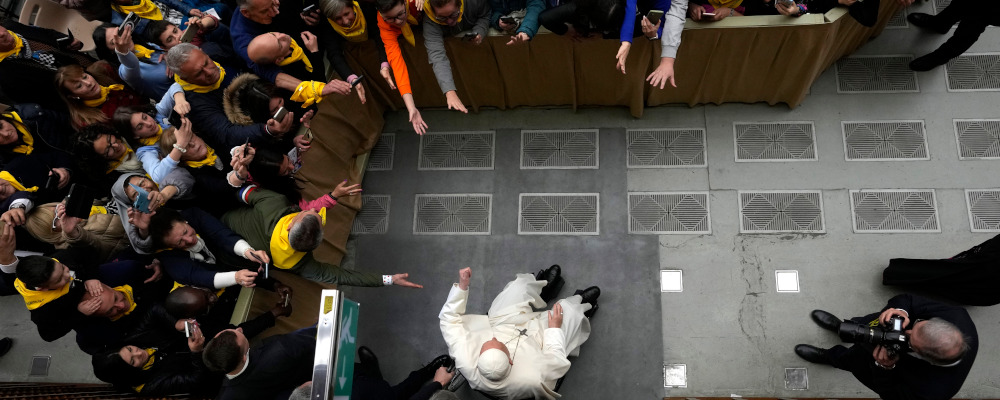In the latest Hub book review, Patrick Luciani examines Mary Ann Glendon’s In The Courts of Three Popes: An American Lawyer and Diplomat in the Last Absolute Monarchy of the West (Image, 2024), which provides a piercing look into one of the most powerful institutions in the world across the rule of three different popes.
To most, the Vatican is a mystery. How corrupt is it? Who’s in charge? Even most Catholics know little about the Holy See’s operations.For clarification, the Vatican is the actual structure or independent country within the city-state’s walls, while the Holy See is from the Latin “sedes,” or seat of power, run by the administration known as the Curia. Mary Ann Glendon’s In The Court of Three Popes gives us a glimpse into these questions, including a year as U.S. ambassador to the Vatican under George W. Bush. It’s also a memoir of her life, career, and how she found herself working in the courts of three pontiffs.
Professor Glendon came to the attention of Pope John Paul II through her legal writings on women as the Learned Hand Professor of Law at Harvard University. In 1995, she was asked to head the Vatican’s delegation to the United Nations Conference on Women in Beijing. There, she discovered that the UN’s stance on helping women differed from hers and the Vatican’s. Progressives from European and Western countries were interested in political and sexual rights and access to abortion with little concern for support needed by mothers and poor single parents or the importance of education and raising healthy families. Here she speaks with practical authority having raised a mixed-race daughter as a single mother.

Glendon’s journey continued under the papacy of Pope Benedict XVI where he and John Paul II supported the need to bring the laity, both men and women, into the Holy See’s administration. As a member of the Papal think tank on social science, she collaborated with other lay members, including Nobel Laureate economist Kenneth Arrow. Despite not being a Catholic, Arrow admired Karol Wojtyla and his mission to open the Vatican to new ideas, a mission that gained momentum after the Second Vatican Council under Pope John XXIII in 1963. She also brought other world scholars and thinkers into the Vatican, including Henry Kissinger and Francis Fukuyama, and not to the pleasure of everyone. After all, the Italians in the Vatican are a jealous lot and still suspicious of foreigners.
Pope Benedict’s primary concern was the encroachment and growing acceptance of relativism and postmodern ideas worldwide, where the pursuit of truth was deemed futile. An intellectual himself, Benedict was also a great defender of America’s constitutional support for the separation of church and state and believed in the coexistence of faith and reason in sectarian life.
President George W. Bush greatly admired Pope Benedict when he asked Professor Glendon to be his ambassador to the Vatican in his last year in power. But sending official representatives to the Vatican from the U.S. is relatively new in American history.
American Protestants—including Eleanor Roosevelt who discouraged President Harry Truman from sending representatives to the centre of Roman Catholicism after the Second World War—always held deep suspicions and distrust of the papacy. President Ronald Reagan appointed the first ambassador in 1984 when he learned that Rome was the centre of international intrigue. And if he wanted to know what the Russians were up to, Rome was the place to be. Henry Kissinger once said that the Holy See “collects a great deal of intelligence from all over the world but doesn’t know how to use it.”
(When Kissinger accepted Professor Glendon’s invitation to spend the night in the Vatican’s spartan accommodation that included a small room, single bed, and tiny desk, he was dismayed when he found out there was no room service.)
Professor Glendon believes that Pope Benedict and President Bush never received the credit they deserved for their support of the poor: the U.S. as the world’s largest donor of humanitarian aid, especially to the 1.4 million AIDS sufferers in Africa, and the Catholic Church as the world’s largest “hands-on providers of health care, education and general aid to the poor.” Pope Benedict’s visit to the U.S. was the only time the president went to Andrew’s Air Force Base to greet a head of state. There he declared that Benedict was the world’s greatest spiritual leader. Their relationship was such that there were rumours that Bush was contemplating converting to Catholicism.

Professor Glendon was intellectually and spiritually in sync with Popes John Paul and Benedict; it was a different question with Pope Francis. Though she admired his dedication and common touch, she often found his statements on Church doctrine inconsistent and occasionally troubling. His off-the-cuff remarks would sometimes get him into trouble, such as delving into unchartered international questions, including the Russia-Ukraine war, implying Ukraine provoked Russia. And she certainly would not have been pleased with the Pope’s careless apology for genocide when he visited Canada in the summer of 2022 when apologies can be “opportunistically exploited.” Nonetheless, Pope Francis appointed Professor Glendon to a commission to investigate the accusations of corruption of the Vatican Bank, known as The Institute of Religions Works (IOR), an institution that goes back to the eighteenth century.
But the IOR isn’t a bank in the traditional sense. It disperses funds collected from churches around the world for charitable purposes. However, funds not distributed are invested, and that’s where the problems start giving most an image of corrupt priests out of The Godfather Part III. After all, Glendon was warned that “the Devil lives in the IOR.” Something she came to believe, especially when she was paid for her travel expenses by the Vatican in white envelopes filled with U.S. dollars. But the closer the external inspectors got to the problems of IOR, competent inspectors and employees were dismissed, while schemers and sycophants rose. The IOR was a classic case of institutional and bureaucratic public choice theory. Not only the Devil, but human nature lives deep in the bowels of the Curia.There was some hope that Australian Cardinal George Pell would clean out the Holy See’s Augean Stables. Unfortunately, he was undermined by Cardinal Giovanni Becciu, who acted as the Pope’s chief of staff and now stands trial for embezzling and misappropriating millions of dollars of Vatican funds to friends and family while undermining his opponents, including Cardinal Pell.
Then, there’s the sexual abuse in the church. Though Professor Glendon doesn’t dwell too much on the topic, she was disgusted when the news broke of the abuse of minors. She was also dismayed by the media’s accusations that the Church was the main locus of child abuse. She reminds the reader that two major studies at John Jay University found that other institutions where abuse was more extensive, yet the media failed to cover those stories as extensively as the Catholic Church.
The Courts of the Three Popes is a masterwork of storytelling, coupled with great writing and honest reporting. Anyone looking for a dispassionate view of how the Vatican operates today, with all the good and bad, should read it. Mary Ann Glendon has written an instant classic.
Recommended for You

Need to Know: Legacy media has a diversity problem

‘A celebration of the spirit of Alberta’: Ryan Hastman on the political, economic, and cultural importance of the Calgary Stampede

‘Can we actually be an independent country?’: Michael Ignatieff on the 60th anniversary of Lament for a Nation

Fred DeLorey: Why the NDP may be in even bigger trouble than we think




